182 Search Results for rett
February 25, 2015
by Carole Zangari -
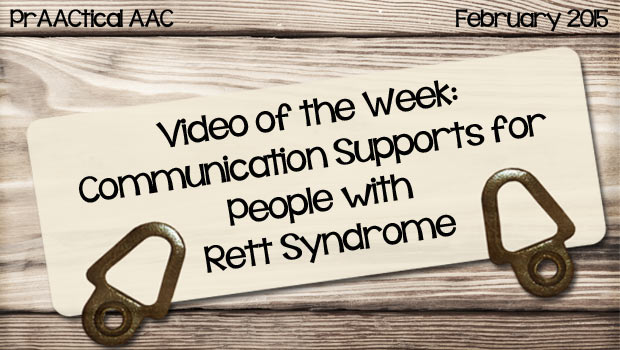
Educational specialist Susan Norwell and OT Judy Lariviere provide a wealth of information on going beyond yes/no and choicemaking to build real communication in girls affected by Rett Syndrome. Thanks to the Rett Syndrome organization for making this video available.
February 26, 2014
by Carole Zangari -
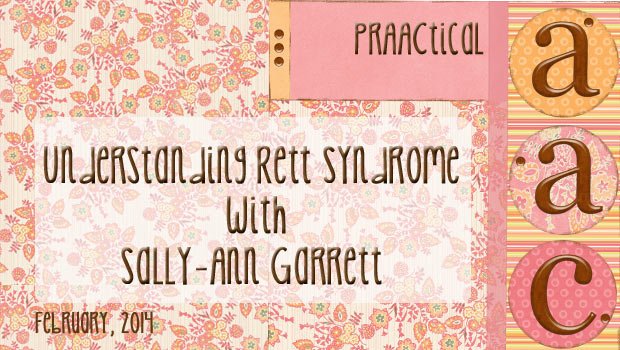
When we did our graduate training, there was little or no mention of Rett Syndrome, a genetic disorder involving a mutation of the MECP2 (Methyl CpG Binding Protein 2) gene on the long arm of the X chromosome. It is a complex disorder and the abilities of those who are affected by it are generally masked by the motor challenges that are a part of Rett. We’ve asked some professionals experienced in Rett and AAC to help us use this space to help us gain a better understanding of the disorder and its implications for AAC intervention. Sally-Ann Garrett (Highly Specialist Speech and Language Therapist; Reg. HCPC; MRCSLPT, Reg. ASLTIP) is one who agreed to do so and we are grateful for her perspective. Sally-Ann is semi-retired now but has worked with girls affected by Rett Syndrome for 30 of her 42 years as an SLT. She lived in Canada for a number... [Read More...]
May 23, 2013
by Carole Zangari -
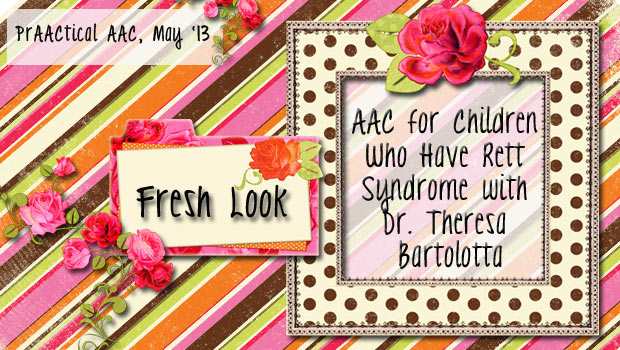
In our SLP training programs, few of us learned about Rett Syndrome or how to provide services to children with that disorder. We’re so pleased to have a guest post on AAC services for children with Rett by Dr. Theresa Bartolotta, Director of Assessment in the Office of the Provost, and Associate Professor in the Department of Speech-Language Pathology, at Seton Hall University, in South Orange, New Jersey. An SLP with over 30 years of clinical experience, she specializes in communication disorders in children with significant disabilities with a special interest in autism and Rett syndrome. Our field is still learning about Rett syndrome and we are still discovering new things about the range of skills and abilities present in the children who have it. In this post, Dr. Bartolotta gives us some background about the syndrome and discusses implications for treatment. I am thrilled to have this opportunity to post... [Read More...]
December 26, 2024
by Carole Zangari -
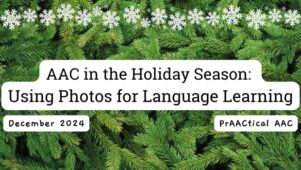
Whether you celebrate Hanukkah, Christmas, Kwanzaa, or some combination of holidays, these events offer rich opportunities for building language in people who use AAC. There’s a good chance that someone took photos which can be a terrific source of motivating materials. In this post, we’ll look at a few ideas for using those to strengthen language and communication skills. Collect them into a photo album: Use PowerPoint, Keynote, or an app to pull the photos together into a collection that can serve as a highly motivating context for language learning activities. With these albums we can: Page through them together to practice making comments (e.g., cold; I see tree, That is pretty), Co-create a narrative about the picture, Work on morphological goals such as pluralization and verb tenses, and, Build longer sentences (e.g., ‘hot chocolate’ becomes ‘drink hot chocolate’ or ‘make more hot chocolate’). Create a photo collage: Work with the... [Read More...]
October 3, 2024
by Carole Zangari -
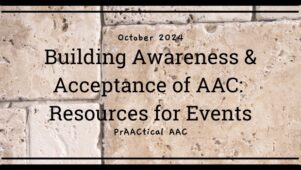
Established in 2007 by ISAAC’s LEAD Committee, AAC Awareness Month invites us to spread the word about all things AAC, and it’s pretty exciting to think back on all we’ve done and also to plan for the current year. Each week during AAC Awareness Month, we’ll share suggestions for things to do to help others learn about a field that emerged to support children and adults with complex communication needs. This week, we’ll focus on hands-on activities. A popular approach to AAC Awareness Month is to invite a group of colleagues or families to come together and communicate only through AAC for the event. Some years, we’ve held ‘Silent Snack’ events before class, where we put out a variety of board games and invited some of our AAC clients to come in and play along. They enjoyed serving as our AAC Ambassadors, meeting new people, and ‘wow-ing’ the crowd with... [Read More...]
May 2, 2024
by Carole Zangari -
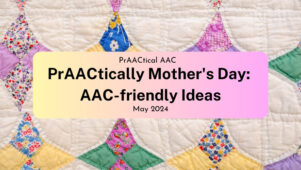
Here in the US, we’ll be celebrating Mother’s Day soon. If you’re looking for resources that you can incorporate into your AAC work, we have some ideas for you. These are great for highlighting core vocabulary, such as these: Pronouns: I, you, she, we, her, our Verbs: can, do, give, help, like, love, make, read, see, write Adjectives: good, nice, pretty, smart, strong Conjunctions: and, because, but, with Time Words: later, now, today, tomorrow Questions: what, who, where ACTIVITY SUGGESTIONS Read about Mothers and Mother’s Day with some of these books. Mother’s Day Book for Early Communicators by AAC with Annie Mother’s Day book highlighting core words ‘like’ and ‘give’ from Speech by Carrie. You can also check out this one which focuses on the words ‘help’ and ‘make’ and offers practice with several pronouns. From Boardmaker From Tarheel Reader (SDJ) From Tarheel Reader (Nicolaus) Cards and letters... [Read More...]
November 3, 2023
by Carole Zangari -
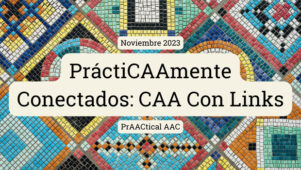
Each month we feature a Spanish version of our AAC Link Up, CAA con Links. If you have AAC-related announcements, materials, or videos in Spanish that you would like others to know about, we’d love to have you add that information below. Also, please share this with anyone who might be interested in contributing to or using the materials that get added to these posts. You’ll find the place to add that information at the very bottom of this post. Organized by Claudia Marimón, these monthly posts also feature AAC work being done in Spanish-speaking countries and offer translations of material that can help families and service providers. Today’s post focuses on some of the AAC Awareness Month activities held in Spanish-speaking areas, including two recorded video presentations. Take a look at the information, and don’t forget to scroll to the bottom to add your link and see what others... [Read More...]
October 9, 2023
by Carole Zangari -
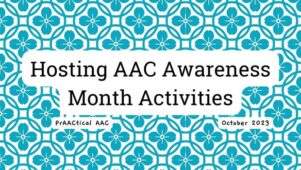
Established in 2007 by ISAAC’s LEAD Committee, AAC Awareness month invites us to spread the word about all things AAC, and it’s pretty exciting to think back on all we’ve done and also to plan for the current year. Each week during AAC Awareness Month we’ll share suggestions for things to do to help others learn about a field that emerged to support children and adults with complex communication needs. This week, we’ll focus on hands-on activities. A popular approach to AAC Awareness Month is to invite a group of colleagues or families to come together and communicate only through AAC for the event. Some years, we’ve held ‘Silent Snack’ events before class where we put out a variety of board games and invited some of our AAC clients to come in and play along. They enjoyed serving as our AAC Ambassadors, meeting new people, and ‘wow-ing’ the crowd with... [Read More...]
May 8, 2023
by Carole Zangari -
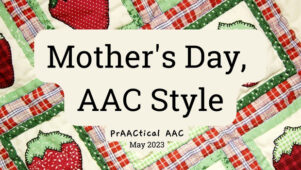
Here in the US, we’ll be celebrating Mother’s Day soon. If you’re looking for resources that you can incorporate into your AAC work, we have some ideas for you. These are great for highlighting core vocabulary, such as these: Pronouns: I, you, she, we, her, our Verbs: can, do, give, help, like, love, make, read, see, write Adjectives: good, nice, pretty, smart, strong Conjunctions: and, because, but, with Time Words: later, now, today, tomorrow Questions: what, who, where ACTIVITY SUGGESTIONS Read about Mothers and Mother’s Day with some of these books. Mother’s Day Book for Early Communicators by AAC with Annie Mother’s Day book highlighting core words ‘like’ and ‘give’ from Speech by Carrie. You can also check out this one which focuses on the words ‘help’ and ‘make’ and offers practice with several pronouns. From Boardmaker From Tarheel Reader (SDJ) From Tarheel Reader (Nicolaus) Cards and letters... [Read More...]
March 16, 2023
by Carole Zangari -

We are pleased to publish the second post in a series on multilingual AAC support guest authored by BilingüeAAC. BilingüeAAC is a group of SLPs with a shared belief in providing evidence-based intervention strategies and resources to bilingual Spanish AAC clients, families, caregivers, and professionals. In today’s post, they introduce us to their framework for AAC intervention that is culturally and linguistically affirming. BilingueAAC Framework to Cultural-Linguistic AAC Intervention Bilingualism in AAC is the best practice and essential to equitable communication access for people with complex communication needs (McNamara, 2018). However, resources are limited to implementing “best practices” and the “how to” incorporate bilingualism and AAC. When we look at the research, we find a variety of cultural considerations (ASHA) but no definite guideline or framework on how to approach assessment and implementation for AAC users with linguistically diverse backgrounds. Providing bilingual AAC intervention is an inclusive and equitable practice. Bilingual... [Read More...]









